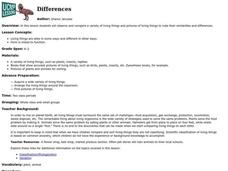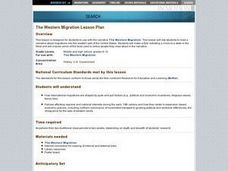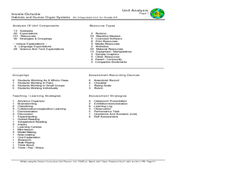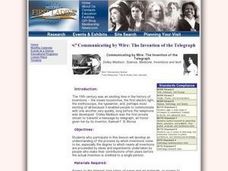Curated OER
Old Photographs: Windows to the Past
Students examine several types of old photographs and compare them to photography today. Students search for historical photographs and draw conclusions about the time period from the subject matter. Students explain how a camera...
Curated OER
Applied Science- Built environment Lab (Trains)
Learners examine transportation. In this train design lesson, students study how trains work and how to efficiently design a track by working with an electric train set. As a class they compare various types of trains and work...
Curated OER
Electric Motors
Students examine the different types of electric motors including their history and classification. In this motor lesson students complete several experiments with different motors.
Curated OER
Rhythmic Ribbons
Students practice various locomotor skills and to provide students with the opportunity to experiment with movement to music.
Curated OER
Locomotor Letters (Numbers or Shapes)
Students practice a variety of locomotor skills and integrate the writing of numbers, letters and shape drawing. Done with music.
Curated OER
Monsters, Inc.
Students explain what it means to include others into their group, and to work together to solve a problem.
Curated OER
Jogging Chicken Dance
Students engage in a light cardiovascular instant activity while actively listening for audible cues.
Curated OER
Broken Bones
Young scholars listen to a lecture on broken bones. They review the proper first aid techniques and practice setting splints on one another. They observe X-rays and animal bones.
Curated OER
Differences
Learners observe and compare a variety of living things and pictures of living things to note their similarities and differences.
Curated OER
What's the Weather Where You Are?
Students create a weather map while traveling across the country on the train. They study the names of the states, letter recognition and the vocabulary of weather terms.
Curated OER
The Western Migration Lesson Plan
Students examine the western migration in the United States in the early 19th century and identify the factors that caused the migration as well as how government adapted to meet the needs of an expanding country.
Curated OER
Find a Match
Third graders, in pairs, are blindfolded and must find each other across the room by calling out synonyms to each other. They practice with antonyms as well. They can skip, gallop, hop or walk to each other to increase the physical...
Curated OER
Physical Bean Bag
Students practice throwing beanbags at moving targets. They work in pairs and aim at particular targets. They participate in a game utilizing the color of the beanbag and their dexterity.
Curated OER
The Ozone Between Us
Students investigate how ground level ozone occurs in many areas of the country. They study the ozone problems that are associated with population centers.
Curated OER
"Go West, Young Man!"
Students examine reasons why people migrated west. They describe how the geography of the U.S. changed in the 19 th century and design a PowerPoint presentation to convey factors for westward expansion.
Curated OER
Hotter or Colder
Students participate in an activity in which they determine the temperature. They are given different scenerios and they are to state whether it is hot or cold there and comparing it to other scenerios.
Curated OER
Highway Tag
Students choose one space on a line as their personal space while other classmates are choseen to be the taggers. Individually, they move along the line staying clear of the taggers. Within a specific time limit, new taggers are chosen.
Curated OER
Inside Outside: Habitats and Human Organ Systems
Students examine the way habitats and human organ systems function. In groups, they role play the role of a government group assigned to determine if a settlement can make their home in a specific area. They must discover how humans and...
Curated OER
On The Move
Fourth graders solve basic mathematical problems. They identify and apply key terms and equations relative to physical science. They discuss how train engines use fuel to move a generator, which creates electrical current that moves...
National First Ladies' Library
Eli Whitney: A Top Ten Inventor?
Middle schoolers conduct research and present their findings in a persuasive manner. Then they work in groups to enhance the development of cooperative work skills. Students also present their findings through persuasive skills in...
Curated OER
Characteristics of Arthropods
In this arthropods worksheet, students will review arthropod exoskeletons, jointed appendages, molting, and types of respiratory structures. Students will also review arthropod senses, body systems, and reproduction. This worksheet has 6...
Curated OER
Skin: The Body's Protection
In this skin worksheet, students will compare the characteristics of the epidermis and the dermis. Then students will complete 2 short answer questions.
Curated OER
Collecting Plankton
In this science worksheet, students learn facts about plankton by reading two pages of factual information. Students read about the different kinds of plankton and how it is classified. Detailed drawings are included. There are no...
Curated OER
Eukaryotic Cell Structure
In this cell structure activity, students review the structure and function of eukaryotic cells. Students also compare and contrast an animal cell with a plant cell. This activity has 15 fill in the blank, 8 true or false, and 7 matching...
Other popular searches
- Locomotion Dance Steps
- Human Locomotion
- Woodson Locomotion
- Fish Locomotion
- The Locomotion Dance Steps
- Locomotion Patterns
- Locomotion by Woodson
- Bipedal Locomotion
- Dance Locomotion
- Mandrill Locomotion
- Salmons Locomotion
- Locomotion Lesson

























